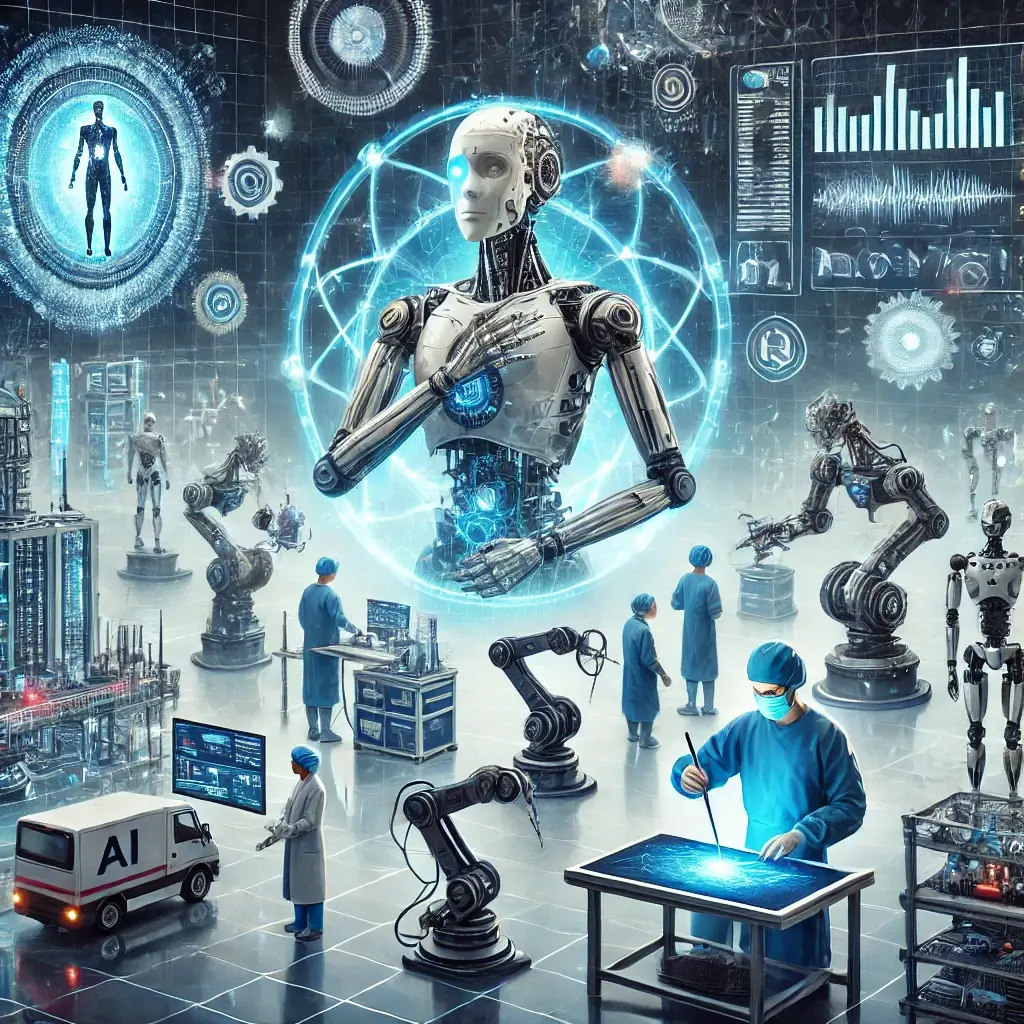-
How Digital Nomads Are Redefining Work and Lifestyle 🌍💻
Mar 06, 2025 | 39 Comments -
How Artificial Intelligence is Transforming Healthcare 🏥🤖
Mar 06, 2025 | 0 Comments -
How Cryptocurrency is Reshaping the Global Economy 💰🌍
Mar 06, 2025 | 0 Comments -
How to Build a Strong Personal Brand: Stand Out & Grow Your Influence 🚀📢
Mar 02, 2025 | 0 Comments -
The Power of AI in Business: How Artificial Intelligence is Transforming Industries 🚀🤖
Mar 02, 2025 | 0 Comments -
How Smart Homes Are Changing the Way We Live 🏡🔋
Mar 02, 2025 | 0 Comments -
How Electric Vehicles Are Revolutionizing Transportation 🚗⚡
Mar 02, 2025 | 0 Comments -
The Future of Renewable Energy: How Green Technology is Changing the World 🌍⚡
Mar 02, 2025 | 0 Comments

The Future of Robotics: How AI and Automation Are Transforming Industries
Robotics is advancing at an unprecedented pace, with AI and automation driving innovation across industries. From self-learning industrial robots to AI-powered humanoids, the future of robotics promises increased efficiency, productivity, and human collaboration. As automation becomes more sophisticated, businesses and consumers alike must prepare for a world where robots are seamlessly integrated into daily life.
The Role of AI in Robotics
Artificial intelligence is revolutionizing robotics by enabling machines to learn, adapt, and interact with their environments. AI-driven robots can perform complex tasks with minimal human intervention, making automation smarter and more efficient.
1. Machine Learning in Robotics
AI-powered robots use machine learning to improve performance over time.
- Robots learn from past actions to optimize efficiency.
- AI enhances robotic precision in repetitive tasks.
- Deep learning enables robots to recognize patterns and predict outcomes.
2. Computer Vision and Object Recognition
AI-driven vision systems allow robots to recognize objects and navigate environments.
- Robots identify and sort objects in manufacturing.
- AI-powered drones navigate using real-time image processing.
- Autonomous vehicles use AI vision to detect pedestrians and obstacles.
3. Natural Language Processing in Robotics
AI enables robots to understand and respond to human speech.
- Voice assistants and chatbots use NLP for customer interactions.
- AI-powered humanoid robots engage in natural conversations.
- Service robots assist with customer inquiries in retail environments.
Industrial Automation and Smart Factories
Manufacturing and industrial sectors are leveraging robotics to enhance productivity and reduce costs.
1. Robotic Process Automation (RPA)
RPA automates repetitive tasks, improving business efficiency.
- AI automates data entry, reducing human error.
- Chatbots handle routine customer support inquiries.
- Robotic arms assist in product assembly lines.
2. Collaborative Robots (Cobots)
Cobots work alongside humans in industrial settings, enhancing productivity.
- AI-powered cobots assist with precision manufacturing.
- Robots adapt to human movements for safer interactions.
- Wearable robotics enhance worker strength and endurance.
3. AI in Supply Chain and Logistics
AI-powered robots streamline supply chain operations.
- Automated warehouses use robotic sorting and packaging.
- AI-powered drones deliver goods with precision.
- Self-driving trucks enhance transportation efficiency.
Robotics in Healthcare and Medicine
The medical industry is integrating robotics for surgery, diagnostics, and patient care.
1. Robotic Surgery and AI-Assisted Healthcare
AI-driven robotic surgery enhances precision and reduces recovery time.
- AI-assisted robotic arms perform minimally invasive procedures.
- Machine learning predicts patient recovery outcomes.
- AI-powered diagnostics improve medical imaging accuracy.
2. AI in Elderly and Disability Care
AI-powered robots assist in healthcare and home care settings.
- Companion robots provide emotional support for seniors.
- AI-driven prosthetics enhance mobility for amputees.
- Robots assist patients with mobility and rehabilitation exercises.
3. AI in Pharmaceutical Research
AI accelerates drug discovery and medical research.
- Machine learning analyzes chemical compounds for drug development.
- AI predicts drug interactions and side effects.
- Robotic lab automation speeds up research processes.
AI-Powered Humanoid Robots
Humanoid robots are evolving to assist in customer service, education, and entertainment.
1. AI-Powered Customer Service Robots
Businesses are deploying humanoid robots for customer interactions.
- Robots greet customers in hotels and retail stores.
- AI-powered virtual assistants provide shopping recommendations.
- Speech recognition enables natural conversations with customers.
2. AI in Education and Learning
AI-driven robots are revolutionizing the education sector.
- Robots assist teachers in interactive learning.
- AI tutors provide personalized learning experiences.
- Educational robots engage students in STEM subjects.
3. Humanoid Robots in Entertainment
AI-powered robots are transforming the entertainment industry.
- Interactive robots enhance theme park experiences.
- AI-driven animatronics bring characters to life.
- Robotic performers participate in live shows and films.
Challenges and Ethical Considerations in Robotics
As robotics technology advances, ethical and safety concerns must be addressed.
- Job Displacement: Automation may replace human jobs in certain industries.
- AI Bias: Robots must be programmed without biases in decision-making.
- Security Risks: Cybersecurity measures must prevent hacking of AI-powered robots.
- Human-Robot Interaction: Ethical considerations around AI decision-making in critical tasks.
The Future of Robotics by 2030
The next decade will see robots becoming an integral part of daily life.
1. AI-Enhanced Autonomy
Robots will operate with minimal human intervention.
- Self-learning AI models improve robotic adaptability.
- AI-driven personal assistants enhance daily productivity.
- Autonomous household robots assist with chores.
2. Space Robotics and Exploration
AI-driven robots will assist in space missions.
- Autonomous rovers explore distant planets.
- AI-powered drones navigate space environments.
- Robotic arms construct structures on the Moon and Mars.
Conclusion
AI-powered robotics is revolutionizing industries, from healthcare to logistics and manufacturing. As automation advances, robots will become more autonomous, efficient, and intelligent. Businesses and individuals must adapt to this robotic revolution, ensuring that AI-driven technologies enhance human capabilities while addressing ethical challenges.
0 comments
No comments yet. Be the first to comment!
Your comment